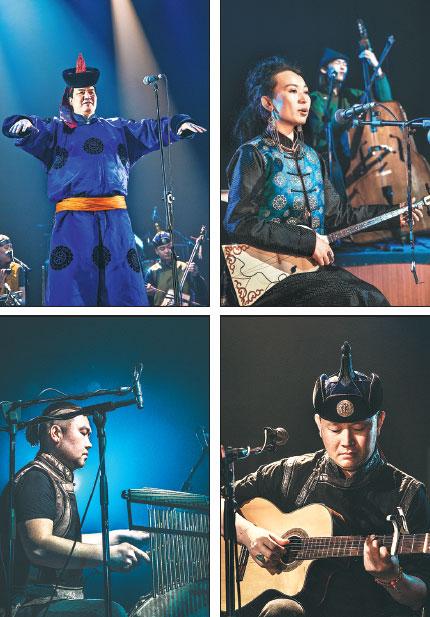Nomadic chant
By Chen Nan (China Daily) Updated: 2017-04-06 06:31The Chinese band Anda Union tours the United States with sounds of the Mongolian grasslands, Chen Nan reports.
The Chinese band Anda Union gave its first performance of the year at the Lincoln Center for the Performing Arts in New York ahead of Spring Festival on Feb 6.
The members sang old folk songs of the Inner Mongolia autonomous region, where they come from, and played indigenous instruments like the morin khuur (horse-head fiddle).
They also performed traditional khoomei, or throat-singing.
The concert kicked off the band's two-month tour of the United States.
"We are both singing and holding workshops to teach the audience how to play our instruments and the techniques of khoomei," Nars, the band's lead musician, says about the just-concluded tour.
In 2007, the nine-member ensemble toured the US for the first time as part of a collaboration between Arts Midwest, a Minneapolis-based nonprofit, and China's Ministry of Culture.
In the past 10 years, the band has performed in more than 30 states in the US, introducing the culture of Inner Mongolia to audiences with events on college campuses and concerts at theaters. The band also toured the United Kingdom last year, with performances in Glasgow, Liverpool and Oxford, among other cities.
After wrapping up its US tour in early April, the band will return to Hohhot, Inner Mongolia's capital, where the members live.
It will launch a national tour from Suzhou on May 14, which will include Shenzhen, Chongqing and Beijing.
Nars says the band plans to hold workshops during the China tour as well.
Born in the Horqin grasslands of Inner Mongolia, Nars was raised by his herder grandparents and learned to play the morin khuur from his grandfather. Nars went to the city of Chifeng to study music at age 12. Later Nars met the others who would one day become members of Anda Union.
Some of the musicians trained in traditional Mongolian music were with the Inner Mongolia Music and Dance Troupe before the band was founded in 2003.
Their common goal was to find inspiration from old and forgotten songs about the grasslands, horses, the history of Inner Mongolia and folk heroes, while creating a new form of music based on traditional sounds.
The Mongolian word anda is used for "siblings".
In 2006, after winning in the ethnic music category at a tough youth competition, the band got more opportunities at the national level.
The band's latest album, Homeland, recorded in Beijing in 2014 and produced in Canada with help from Grammy-winning recording engineer Richard King, has renewed some interest in the largely forgotten nomadic life.
"Rapid urbanization, pollution and the exploitation of the grasslands have posed a challenge for the traditional Mongolian lifestyle and culture," says Nars. "We want to keep the essence of our culture alive through music."
The title song, Jangar, in the album Homeland reflects a yearning for the grasslands and is inspired by a Mongolian epic. The song was written by the band's morin khuur player and khoomei singer Urgen. The British magazine Songlines named the album among the best of 2016.
"It doesn't matter that people do not understand the language," says Tim Pearce, a British filmmaker, who became the band's manager after watching their performance in Shanghai in 2006 and has toured with the band in the US and UK.
"Their music is truly universal and there is no other band presenting Mongolian music as they are."
In 2009, Pearce traveled with the band to the grasslands of Inner Mongolia, where they discovered old songs and a fast-changing society. After three months of filming and a year of editing, the documentary Anda Union From the Steppes to the City was released in 2011.
One of the band members, singer Tsetsegma, who specializes in performing urtin duu, or long songs that are traditional chanted, joined Anda Union in 2006.
He says every member of the band has a distinct performing style onstage and uses singing techniques and instruments to bring out the full range of Mongolian music.
"The Mongolian culture offers us endless inspiration. We learn about legends of Genghis Khan, Mongolian ethnic tribes and folk tales about love, brotherhood and courage," says Tsetsegma.
In 2016, the musicians of Anda Union were hired to teach at Inner Mongolia Arts University, training young people to play the instruments, and learn songwriting and singing.
"We hope the younger generations, who grew up under the influence of Western art forms, such as hip-hop and rock, will see the beauty of Mongolian music, which is a huge wealth," says Nars.
Contact the writer at chennan@chinadaily.com.cn
|
Anda Union will start its national tour after its twomonth tour in the United States. The band includes (clockwise from top left) Biligbaatar, Saikhannakhaa, Nars and Urgen. Photos Provided To China Daily |
- 'Cooperation is complementary'
- Worldwide manhunt nets 50th fugitive
- China-Japan meet seeks cooperation
- Agency ensuring natural gas supply
- Global manhunt sees China catch its 50th fugitive
- Call for 'Red Boat Spirit' a noble goal, official says
- China 'open to world' of foreign talent
- Free trade studies agreed on as Li meets with Canadian PM Trudeau
- Emojis on austerity rules from top anti-graft authority go viral
- Xi: All aboard internet express












